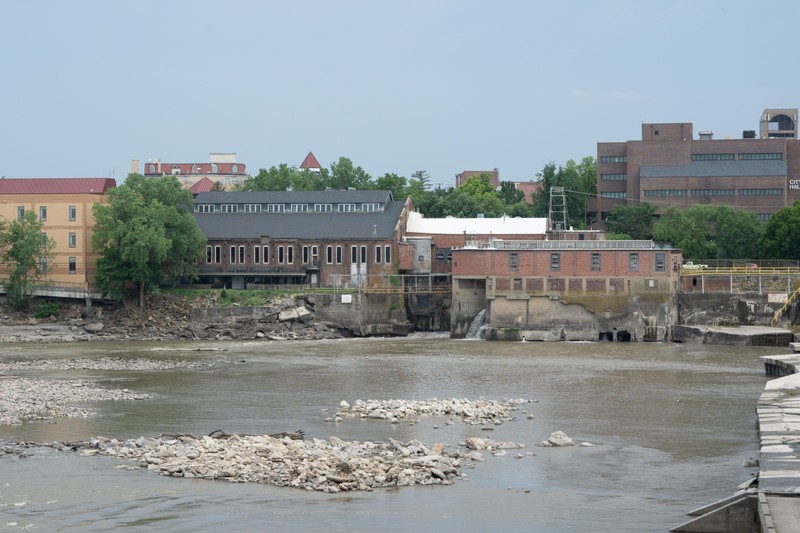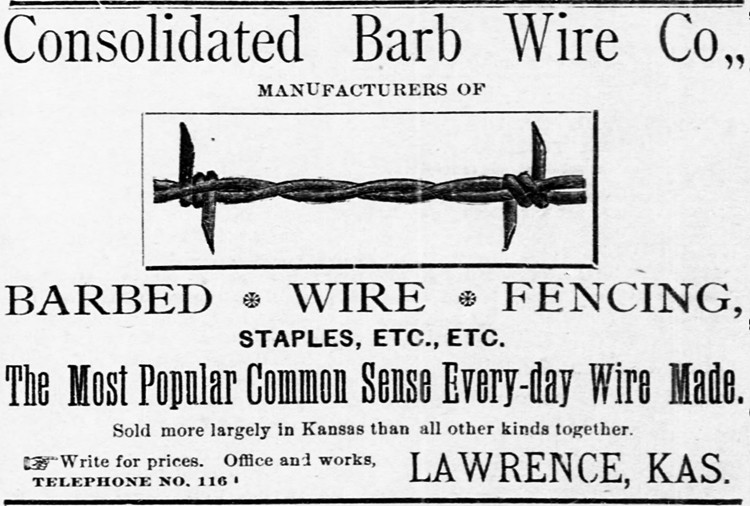Consolidated Barbed Wire Company (Abe & Jakes Landing)
Introduction
Text-to-speech Audio
The historic building now known as Abe & Jake's Landing, a popular wedding and private event venue, was built to house the Consolidated Barb Wire Company in 1893. The Lawrence Paper Company purchased the building in 1907 and used the facility until 1974. The original barbed wire company operated until 1899 and serves as a reminder of the essential nature of this product to the growth of Kansas during the late nineteenth century, as farmers and ranchers needed barbed wire to build fences in the Great Plains where lumber was less prevalent than eastern states. Barbed wire helped transform the central plains of the U.S. from an "open range" to one of consisting of fenced-in ranches and farms. Both commercial businesses benefited from the adjacent Kansas (Kaw) River and the Lawrence Dam which was built around 1879. The building stood vacant for much of the 1980s and fell into disrepair until a ten-year renovation project revived the structure, allowing it to transition into a modern service-industry building during the twenty-first century. The building's new purpose speaks to the city's transition from manufacturing to education and services. It also demonstrates the changing role of the river from transportation and power generation to its connection to downtown service-industry businesses and the way many towns are returning to the river for leisure and recreation.
Images
Abe & Jake's Landing, and the former Consolidated Barbed Wire Company Drawing Mill on the Kansas (Kaw) River

Consolidated Barbed Wire Company advertisement

Backstory and Context
Text-to-speech Audio
When settlers began populating the Great Plains during the second half of the nineteenth century, they encountered an exceptionally unfamiliar environment. Settlers discovered treeless terrain abounding in swaying prairie grasses and flowers stretching from horizon to horizon. The land offered little material that could be used as fencing to mark property lines and contain livestock. Thus, before 1874, numerous Prairie migrants embraced the "open range" idea, allowing cattle and sheep to freely graze on the open prairie, sometimes sharing resources with other settlers. Open-range farming and ranching benefited Native Americans and others who had always moved freely along the Plains, including those migrants who traversed the Plains along the Oregon, California, and Mormon Trails.
Although Lucien B. Smith of Kent, Ohio, received the first patent for barbed wire in 1867, Joseph F. Glidden of DeKalb, Illinois, modified Smith's version and received a patent in 1874 for the modern version of barbed wire. While barbed wire benefitted farmers and ranchers by providing them with cheap, adequate fencing, it ended the era of the open range, which adversely impacted Plains tribes and the buffalo herds they followed and created tensions between Plains residents and the cowboys attempting to traverse the Plains. Cattlemen occasionally cut any barbed wire fence they encountered, sparking a period of "range wars." However, by the late 1890s, the federal government had moved (forced) all of the Plains tribes to reservations, and the entire ranching industry had changed, leading ranchers to change from anti-barbed wire to use it to fence their cattle; barbed wire went from controversial to highly sought.
The popularity of barbed wire, a byproduct of the steel industry, attracted numerous manufacturers in the 1870s, but only two barbed wire producers existed west of the Mississippi River (in Iowa) until Albert Henley moved to Lawrence in 1878 from Iowa, bringing his four hand-cranked barbed wire machines with him and becoming the town's first barbed wire merchant. One year later, Justin DeWitt (J. D.) Bowersock, the Douglas County Mill and the Kansas (Kaw) River Dam and Waterworks owner, set up a competing barbed wire enterprise. Five years after Henley arrived, Lawrence evolved into a hub of barbed wire manufacturing with four companies in operation.
Led by Henley and Bowersock, the barbed wire producers merged in 1883, creating the Consolidated Barb Wire Company. The new company enjoyed immense success, ostensibly developing into a regional (western) monopoly. And with that success came a need for a new mill and building, resulting in the now-historic structure on the Kaw River. The company's new drawing mill, which opened in 1892, allowed the company to purchase steel rods instead of read-made wire. As a result, the company could expand the types of products it produced to include plain and barbed wire, wire nails and bail ties, and hay presses.
The arrival of the barbed wire industry in Lawrence came shortly after a substantial economic downturn closed banks and led to a population decline, ending a boom period from the 1860s until roughly 1873 (the U.S. "Panic of 1873" and resultant national economic recession). The rise of Consolidated Barbed Wire provided a boost to a down in need of job opportunities and economic growth. In the 1890s, Lawrence's Consolidated Barbed Wire sent its products to nineteen western states and achieved $1 million in sales (roughly $35 million in 2024). At its peak, the company opened branches in Illinois and Ohio while the Lawrence, Kansas, plant employed more than 300 men (making it the state's largest employer) and supported a steamboat landing stationed on the river below the factory. Unfortunately, the enormous economic boost provided by Consolidated Barbed Wire, notably after the historic mill opened, lasted only a short time because an eastern company purchased Consolidated, leaving the Lawrence plant vacated.
In 1907, the Lawrence Paper Company, which enjoyed a connection to Consolidated Barbed Wire, took over the building and remained its occupant until the 1970s. When Bowerstock helped facilitate the 1883 merger of the local barbed wire companies into Consolidated, it helped him expand his local business empire, mainly located near the Kaw River (where the historic building stands). Bowerstock, who also served as town mayor and as a U.S. Congressional Representative for Kansas during the 1880s, owned an Opera House, two grain mills, a patent medicine firm, an ice house, and much more. Bowerstock's Lawrence Paper Company opened in 1882, so when the Consolidated Barbed Wire building sat vacant for years, Bowerstock eventually moved his paper business into the building in 1907. Lawrence Paper Company produced more than fifteen tons of paper products and became Lawrence's biggest employer in the 1910s; they moved to a larger facility in 1974.
The building sat vacant through the 1980s, becoming dilapidated, but developers resurrected it with a massive, decade-long renovation project. Today, it operates as Abe & Jake's Landing, a huge event space that mainly caters to weddings and corporate functions. Its modern purpose speaks to a change where rivers once existed as essential sources of power and navigation but now routinely serve communities like Lawrence as places of leisure and hubs for the service industry (restaurants, hotels, etc.). Meanwhile, its history reflects the influence and profitability of barbed wire and its significance to Lawrence's history.
Sources
Black, Brian. "Mastering the Kaw: The Bowersock Dam and the Development of Lawrence Industry," Kansas History 16, no. 4 (Winter 1993-94): 262-275.
Caviness, Paul O.. Building History: The Consolidated Barb Wire Company Drawing Mill and the Industrial Riverfront of Lawrence, Kansas. Self-Published: Caviness, 1988.
--- --- ---. "Registration Form: Consolidated Barbed Wire Company Drawing Mill." National Register of Historic Places. kshs.org. 1988. https://www.kshs.org/resource/national_register/nominationsNRDB/Douglas_ConsolidatedBarbWireDrawingMillSR.pdf.
"History." Abe & Jake's Landing. abejakes.com. Accessed January 12, 2024. https://abejakes.com/historyofabejakeslanding.
McFadden, Joseph M. "Monopoly in Barbed Wire: The Formation of the American Steel and Wire Company." The Business History Review 52, no. 4 (1978): 465–89. https://doi.org/10.2307/3113415.
Michaelis, Patricia A. Settling the Kansas Prairies — With Barbed Wire. Lawrence Business Magazine. 2017. https://lawrencebusinessmagazine.com/2017/06/17/barbed-wire/.
Wolfenbarger, Deon. "Multiple Property Documentation Form: Historic Resources of Lawrence, Douglas County, Kansas." National Register of Historic Places. lawrenceks.org. 1997. https://assets.lawrenceks.org/pds/planning/documents/lawrencethematicnr.pdf.
--- --- --- "Registration Form: Lawrence's Downtown Historic District." National Register of Historic Places. nps.gov. 2004. https://npgallery.nps.gov/NRHP/GetAsset/NRHP/04000685_text.
https://www.emily-lynn.com/2018/05/14/top-5-reasons-you-should-get-married-in-lawrence-ks/
Kansas State Historical Society, kansasmemory.org, and included in an article on https://lawrencebusinessmagazine.com/2017/06/17/barbed-wire/
